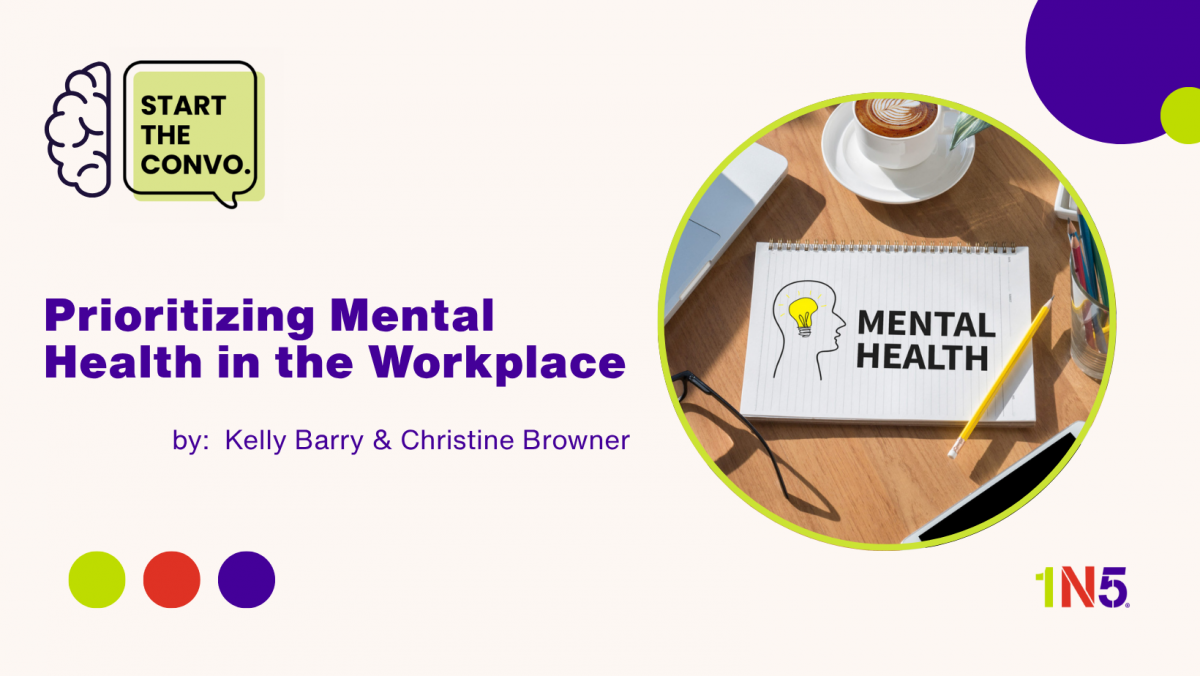Written by Christine Browner, M.Ed., RN, OCPS & Kelly Barry, M.S., CHES, NBC-HWC, OCPSA
Each May, Mental Health Awareness Month offers a valuable opportunity to raise awareness about mental health, reduce the stigma surrounding mental illness, and support those who may be struggling. It’s also a timely reminder that mental well-being matters in every part of our lives – including at work, where many of us spend a large portion of our lives. That makes Mental Health Awareness Month the perfect time for organizations to reflect on how they’re supporting employee mental health – and consider trying something new.
Why Mental Health in the Workforce Matters
All of us have mental health. As we at 1N5 like to say: if you have a brain, you have mental health.
Mental health isn’t something we can leave at the door – it travels with us into every part of life, including the workplace. According to the Substance Abuse and Mental Health Services Administration (SAMHSA), more than 1 in 5 adults in the United States (23.1%) live with a mental illness. That number jumps to 36.2% among young adults aged 18–25, the highest of any age group.
But here’s the thing—mental health challenges don’t wait until after work to show up. Anxiety, depression, stress, burnout, and other conditions often follow people into the office, impacting relationships, performance, and overall productivity.
When Workplaces Look the Other Way
When employee mental health isn’t prioritized, the impact can be felt across the entire organization—through high turnover, decreased productivity, and rising healthcare costs. Globally, depression and anxiety contribute to an estimated $1 trillion in lost productivity each year. In the U.S. alone, job-related stress is estimated to cost businesses $300 billion annually, factoring in absenteeism, turnover, reduced performance, and medical, legal, and insurance expenses.
Avoiding conversations about mental health in the workplace can unintentionally reinforce stigma, making it harder for people to seek the help they need. On average, there’s an 11-year gap between the onset of mental health symptoms and the start of treatment. When employees feel safe talking about mental health, they’re more likely to get life-changing help sooner.
But beyond the numbers and bottom-line impact, mental health in the workplace is about caring for an organization’s most valuable asset: its people.
What Makes a Mentally Healthy Workplace
A mentally healthy workplace is one where employees feel valued, supported, and safe – both emotionally and psychologically. This starts with psychological safety, where employees feel safe to speak up without fear of judgment or retaliation. It’s a place where conversations about mental health are not only welcomed but encouraged.
Equally important is a sense of belonging. When employees feel connected, respected, and included, they’re more engaged, more likely to stay in their roles, and tend to take fewer sick days. Creating an inclusive work environment doesn’t happen by chance – it’s the result of intentional efforts to build trust, prioritize well-being, and create space for everyone to feel like they truly matter.
“Supporting mental health in the workplace doesn’t require big budgets or complicated programs—it starts with creating space for real conversations and treating people like humans first. When employees feel safe, valued, and supported, everyone benefits.”
— Kelly Barry, Workplace Senior Program Manager, 1N5
Best Practices for a Mentally Healthy Workplace
- Train organizational leaders: Teach leaders to recognize signs and symptoms of mental health challenges and how to support employees without becoming their “therapist” or “healthcare provider”. Supporting people isn’t about fixing it; it’s about listening with non-judgmental curiosity and connecting with empathy.
- Educate employees: Make sure all employees are aware of available resources supporting mental health. Discuss these the same way you do any other benefits (PTO, dental, etc.).
- Normalize boundaries and self-care practices: Look for opportunities to add flexibility and autonomy to work responsibilities. Consider offering hybrid work, flexible hours, or mental health days.
- Foster authentic connections: Psychological safety (felt safety) starts with feeling like you’re cared about as a human being. Play is a great way to help build these connections in an easy, non-threatening way.
- Talk about it: Open communication about the importance of mental health helps employees feel comfortable discussing their mental health concerns and seeking help without fear of judgment or stigma. Include mental health in staff meetings, internal newsletters, and onboarding materials.
While Mental Health Awareness Month is a powerful starting point, mental health and wellness aren’t conversations reserved for May. Real change happens through consistent, intentional action every day, all year long.
Everyone in an organization – from leaders to frontline staff – plays a critical role in building a positive work culture. When we prioritize our own well-being, speak openly about mental health, and create space for others to do the same, we lay the foundation for a supportive workplace where individuals thrive. And when individuals thrive, so do the organizations they’re part of.

